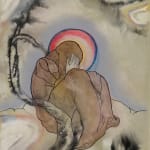Charles-Clos Olsommer (1883-1966)
Born in Neuchâtel, Charles Closs Olsommer spent most of his life in Swiss small villages in the Valais. His artistic journey began at the École d’Art in La Chaux-de-Fonds in 1901, followed by further studies at the Kunstgewerbeschule in Munich and Geneva’s École des Beaux-Arts. A member of the Society of Swiss painters, sculptors, and architects, Olsommer received the Federal Fine Arts Grant three times from 1911 to 1913. His extensive travels throughout Europe, including Prague, Bulgaria, and especially the Balkans, left a lasting imprint on Olsommer’s mystical and symbolic approach to art.
In 1912, at the age of twenty-nine, Olsommer chose the village of Veyras in the Valais as the ideal place to fulfill his lifelong artistic quest. Embracing an ascetic and secluded lifestyle, he devoted himself to creating a prolific legacy of mystic figurative drawings. While his early works reveal the influence of the Munich Symbolists, Olsommer later embraced the harmony he found in his remote arcadian surroundings.
Olsommer’s occult art is characterized by its precious and sensual handling of materials, often blending portraiture with allegorical motifs. As a recluse, his favorite models are his wife and children, unveiling his hermetic mysticism and experimental techniques. His depictions of female figures express his metaphysical exploration of transforming the invisible into the visible. The lyrical yet nocturnal atmosphere of his drawings evoke the Symbolist ideal of the sacralized soul. Olsommer’s isolated interpretations diverged from those of his Swiss and other Western European contemporaries, offering unique solutions bridging the mystical with the material.
The sitting figure in contemplation in Mystical figure is a reoccurring motif in Olsommer’s watercolors. As he rarely dates his work, it is complicated to establish a chronology.[1] In the absence of titles, it is even harder to make any interpretations of Olsommer’s symbolist oeuvre. As a strong colorist, with spiraling forms, Olsommer created his imaginary landscapes inhabited by spiritual souls open for interpretation. Experimenting with wet mediums on wet paper, the compositions almost revealed themselves to the artist in a mystical way, avoiding comprehensible communication.
[1] Arnold Kohler, Charles-Clos Olsommer. Un peintre mystique et symboliste, Neuchâtel 1978, p. 227
Provenance
Mathieu Néouze, Paris, 2019



